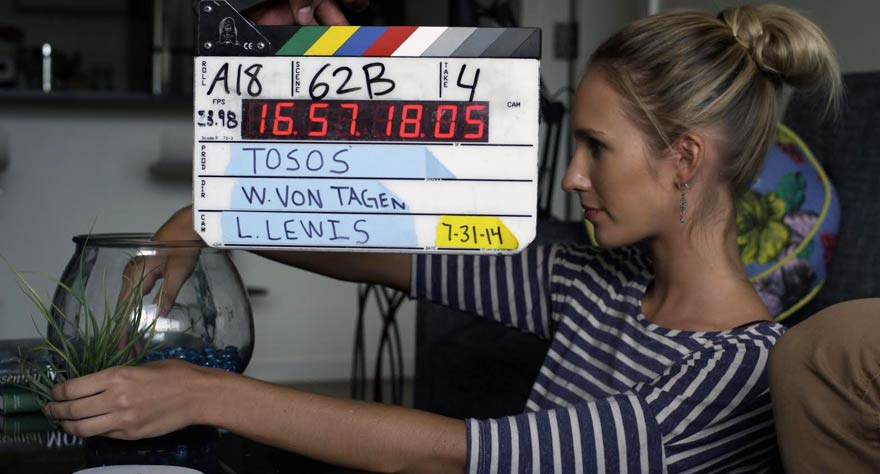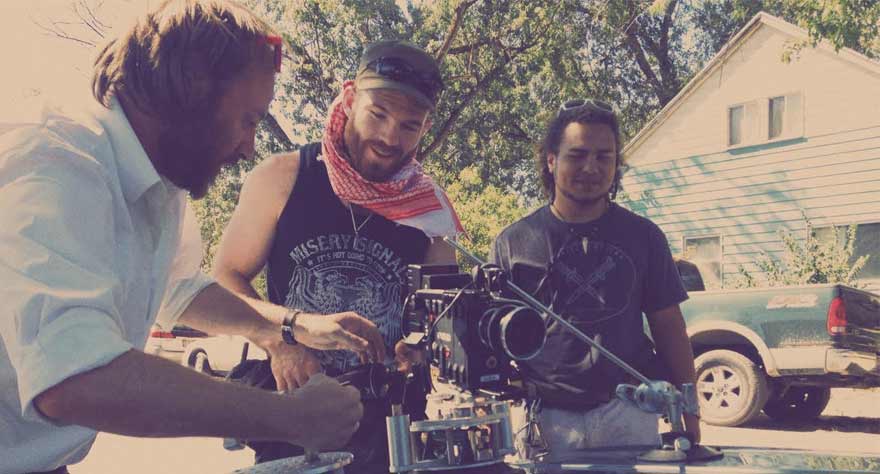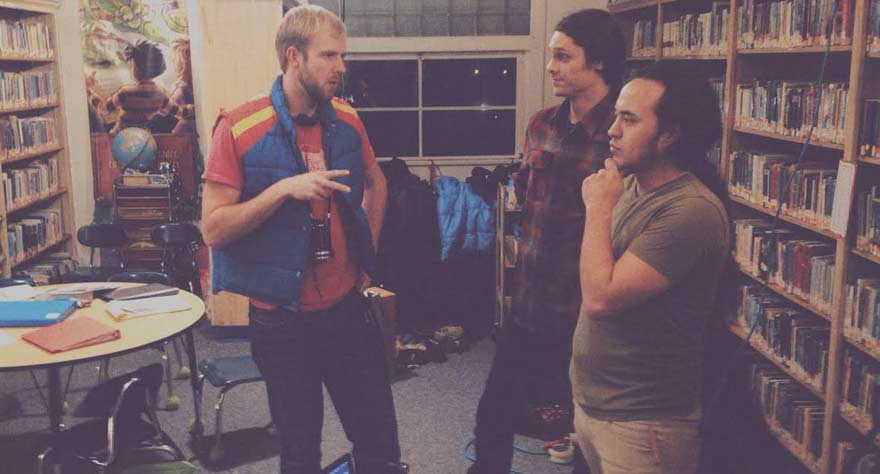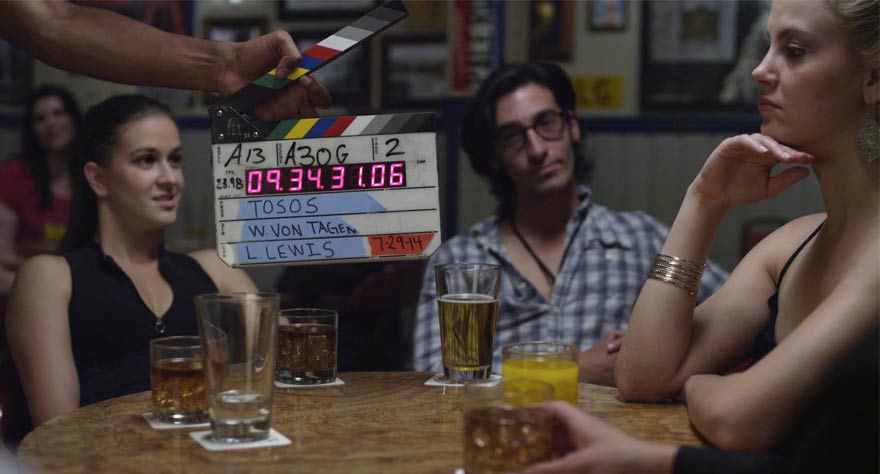Inside Indie Filmmaking: Film Financing and Legalities

Disclaimer: Film financing is the topic I get asked the most about, and therefore, I anticipate this being one of the more-read articles in this series. That being said, it is also the subject that seems to upset people the most. Money is emotional, and the moment it comes into play (especially other people’s money,) the way you approach every issue in the process changes. Where many other directors find this to be a bad thing, I see it as good. I won’t get too into finance-based decision making, but hopefully by explaining the process—what it takes, and what it means for your longevity as a filmmaker—you’ll understand why allowing funding to be a part of the decision making process is beneficial, and in my mind, essential.
The state of Idaho does not offer film grants or incentives. Almosting It was funded 100% through the sale equity shares in the film’s LLC to private investors–as well as several generous in-kind donations from private individuals. No public or tax payer funds were used, nor was any crowdfunding involved in the making or marketing of the film.
Basically this article is about being a producer, and how to produce as a director–because, love it or hate it, I believe that is 100% the direction the industry is moving. P.S. This might get long.
Let me preface this with a story that won’t make a lot of sense at first:
When I was 16-years-old I decided to re-earn my Mile Swim badge at a scout camp a few miles north of Yellowstone. It was early June, and the snow runoff was still making its way down into the lake—resulting in a water reading of 56 degrees and the cancellation of nearly all waterfront activities. After convincing the camp to let me swim my mile, one of the scoutmasters agreed to row the support boat alongside me.
Unlike running, with cold water swimming the harder you work the colder your core temperature will get—so all you can do is just move gradually and tell your mind to deal with it. The swim was the lake and back, twice, with plenty of chances—and encouragement—to just climb out and stop. After an excruciating 45 minutes—a personal worst time—I dragged my quivering self back on to the beach. I was hypothermic (purple never was my color) and was quickly taken to the showers where I sat and recovered for over an hour.
So what’s the point of this story? Is it a metaphor for the process? Am I looking for cyber-high-fives to my past self? No. The point of the story is that ten years later, the man who rowed the support boat was one of the first investors to cut a check toward my film. He didn’t invest because he loves movies, or because he loved the script, or even because he thought he could make some money off the endeavor (you are legally required to inform your investors of all the ways they can lose money on film investing). He invested his personal property because a decade earlier, he saw something that gave him reason enough to believe in me.
That is the key to all of this. Producing is all about selling, but you aren’t selling the film, you are selling yourself. You are giving people a reason to believe in you, and then following through on what you say.

Who to Approach
Everyone knows film is one of the riskiest investments to make. People will literally laugh at you when you bring it up. So you might think: “I’ll get people who understand film! People who are part of the community!” Don’t do this. Especially for the real Indie Auteur out there. While you will (and should) be responsible to your investors, you never want anyone involved who will feel they have any sort of creative pull because they gave you money and are industry savvy. If you think your potential investor will be swayed with the promise of an Exec. Producer credit, that is the last person you should sign. For the sake of your sanity and artistic license, only sign people who understand little about film, and therefore accept you as the boss. (No, you’re not tricking them. Again, be responsible, but people need to trust you to be in charge for this to work.)
There is no great mystery as far as finding individuals to get involved in funding a film. There’s no secret conspiracy, there’s no special in. “It’s all about who you know,” is a common excuse. Sure, that’s very true, but chances are you already know them, and if you don’t, go out, find out who they are, and get to know them. Network.
Start with anyone you know who may have connections, a sound business mind, and who could help you—but DO NOT try and sell to them (at least not yet). Present what you are offering, your plan, and ask for advice and references. Then follow through with a phone call.
“Hi, this is Will von Tagen, I got your number from Mr. X. I’m working on a project that he said you might be interested in. I’d love to set up a time to meet and speak with you more about it.”
This is my script, verbatim. See? Nothing that secret. Allow for three attempts at the phone call, but only leave a message after the first two—otherwise you become a pest. If you don’t get someone the third time, then you need to devise a plan to track them down in person. Okay, it might sound a bit stalker-ish, but how badly do you want to make your movie? Also remember that only a firm, vocal “no” means no. Until then, everything is still on the table and should be pursued. Get the meeting, make the pitch and close.
No matter how your meeting ends, always ask for feedback on how you could have presented things better, and ask if they would be willing to refer anyone they feel might be interested or have ideas for you. This will keep the ball rolling and also make every meeting at least a minor success.
In all, I had about 137 face to face meetings and signed 14 investors–including one investment group. Sure, that’s a ton of time in meetings, but it’s also a 10% success rate, which isn’t bad at all.
Hint: If someone asks you to email them (unless it is to send over the documents) it’s over. This particular world revolves around physical interaction, and emails are too easy to ignore. So push for that phone conversation or physical meeting.

How to Prepare
Here, I again seriously advise purchasing Maureen Ryan’s book, Producer to Producer. It is illegal to just go out and start raising money. You will need an attorney who understands small business start-ups (that’s essentially what you are), SEC regulations and investment law. They will need to help you draft a PPM (private placement memorandum), an operating agreement for the operation of you film-as-a-business, and a subscription agreement to sell the share subscriptions to your investors. Maureen goes into detail on all of this, so seriously check it out, because it has to be done.
A lot of folks (Maureen included) will recommend structuring you film as an LLC, and each investor you sign becomes a co-owner. This is what I did, though after speaking with an Angel Investment Group, next time I will structure the film as a C-Corp. With an LLC, all members are taxable, where in a C-Corp only the business entity itself is responsible for the taxes on profit gains. This is apparently a big deal for many seasoned investors, and most Angel groups will not get involved with an LLC purely for tax reasons.
Physical presentation is huge. Have all your documents organized and easily transportable/transferable. Put only the necessary items in your portfolio, with easy breakdowns up front. My entire PPM portfolio was about 160 pages—with the first three providing all information they might need at a quick glance: personal resume (you’re selling yourself, first), one page synopsis, and a one-page summarizing the offer. The remaining 157 was the detailed breakdown of everything—with the final 50 providing information on the film industry: distribution, exhibition, gross numbers on comparable films, etc.
Get this all modestly bound at the office supply store, and always have two copies—one for you to reference and one for the prospect to look at. (Only give them the copy if they are interested–these cost about $7 a pop to make.)
How to Pitch
The two most important things in the pitch are to be prepared and to be excited. Excitement is contagious, and people want something to be excited about. If you come into a meeting full of that energy, your prospect will sense it and will immediately sense how passionate you are about the project, saving you the time of having to tell them, and letting the meeting stay focused on the business part of things. (Filmmaking 101, right? Show, don’t tell.)
The biggest thing I learned from all my pitch meetings is to actually spend very little time talking about the film itself. Generally, a 30 minute meeting is standard, but plan for 20 minutes total. The opening five is always lost with formalities—finding a seat, getting a coffee, waiting for them to finish up a phone call, etc.—and the closing five should be left as buffer, and for asking for further references and advice.
Spend no more than five minutes talking about the film (plot, inspiration, character, etc.) Your prospect wasn’t chosen because they are film savvy. Have a solid one liner, a good selling paragraph or so, and in that pitch find a way to relate the project to the prospects life. Then move on.
Take ten minutes to talk about the numbers and have a one-sheet available to help break it down. Talk budget. Explain the return on investment—what percentages they stand to see back, when that will happen, and how that will happen. Pick a larger and expected number and run it through the ROI you just explained. Tell them the minimum buy-in cost per share. This is where you really need to have the pitch down and do your homework. This is the real reason they are sitting with you, and if you do not convince them that you know what you are talking about, then even the sweetest deal won’t sell.
Take five minutes for questions and re-explaining what ever part of the pitch got their attention the most.
Finally, ask if this is something they are interested in, and what more they need to come on board. Try and set a second meeting in person right there—ideally within the same week.
You likely won’t close on the first meeting, but you can easily get a commitment. If they want a copy of your PPM (Private Placement Memorandum) give it to them to take and read. It’s also good to have a full-page synopsis printed and placed in your PPM.

Standing Out
The toughest thing to face going into this for everyone is the lack of a track record. So how do you put a potential investor’s mind at ease, since this is your first go and you haven’t proved you can make them money on a film yet?
- Excitement. I kid you not, this is huge. Be excited and sell it.
- Let them know this film is happening no matter what. They can be a part of it, and you would love to have them, but it’s coming regardless, so look out.
- Never look desperate. It’s just as huge of a turn off in courting an investor as it is in dating. You see this all the time in crowdfunding (I’ll touch on that in a bit), but so many crowdfunding campaigns say things like, “please, please help us. It won’t happen without you!” This is a horrible thing to say, and no one with money will want to get behind that sort of appeal because it already sounds shaky. Rather, say “this is an amazing opportunity that is happening, I would love to have you be a part of this with us.”
- Escrow. None of the money raised can or will be touched until the minimum amount needed to make the film is in the bank. This is good security and insurance for your investor that the money won’t be lost without a final product. (Budget about $100 for an escrow holder)
- Name talent. I promised every one of my investors that I would not shoot the film without a recognizable name attached. Name talent is the biggest selling point in funding, filming and distributing a film. (Don’t be daunted at the prospect yet, I’ll get into this when we talk casting.)
- Write a good return of investment. Don’t be greedy. This is your first investor-backed film. Make sure they are well taken care of for handling all the risk on this. I wrote my investors 175% return before any profit could trickle down into the producer/cast/crew shares of ownership.
- Realistic share minimums. I’ve spoken with a lot of indie producers who expect a minimum $25k buy-in for one share. I know another who had $50k. Forget about it. Think about this: even the richest person alive will look at that number and say, “hmm, new car I can buy and drive today, OR one share in an extremely risky endeavor that IF I see anything back on, it won’t be for at least a year or more.” They will always buy the car. I had two investors buy in for over $10k, and one of those was after the film was shot and they liked what they saw. If I had followed a $25k model the film would still only exist on paper.
Our shares were priced at $2,500 a unit, and there were options for partial shares. That’s a risk most people in the minimum income range (yes, that is part of the SEC regulations you have to follow) are willing to take. Plus, they might be more willing to come on for more later on.
Pitfalls and What to Watch Out For
- Close as fast as possible. The longer the offer lingers and the more time that elapses between meeting, the more likely they are to decide it isn’t for them. Don’t waste time with meeting after meeting, hoping they will just write the check. Ask for it. They are expecting it. That is why they met with you. This did cost me big early on. Close and get out.
- It isn’t closed until the check is in escrow or the bank. A signed subscription agreement—though legally binding—isn’t enough. A week and a half before my final payroll I had an investor forfeit on his agreement of $30,000. My entire payroll was suddenly non-existent. If you want to learn what true stress and turmoil is, put yourself in that situation. Two weeks in production, with very little sleep, stressing out daily over rewrites, focusing on directing crew and talent (in my case, also trying to focus on acting), and now you have a week and a half to find $30,000.
I made the gutsy and probably idiotic call to continue production as opposed to stopping until the money was in. I believed I could do it, and knew if I broke production we might never finish. Schedules, locations, talent, rentals—everything would have to be rebuilt and would probably cost even more. I somehow managed to sign a few new investors while in the middle of shooting and we were able to pay everyone. It was a week late—checks that big take time to clear accounts—but we made it and the film was in the can.
These are the type of decisions about responsibility I was talking about. When it is other people’s money you are the guardian of, take everything very seriously. Protect the investment at all costs.
Don’t account for the money until it is physically in the account. Don’t count on a subscription agreement. It isn’t closed until it’s closed.
- Don’t waste time or money. Again, no duh, right? You’d be surprised. I mentioned modestly binding your PPM. Look professional, but skip the frills. You are being judged from moment one on how you manage money. I know a few producers who waste resources on full color, professionally bound “pitch books” that highlight elements of production—key players, concept art, script excerpts, etc. There is not a word about the numbers inside. That’s a great souvenir to hand out in line at festival, but not to an investor. They shouldn’t care about your ideas on wardrobe, and when they see this, they know what it probably will cost and immediately think you are wasting money. You are also wasting their time because they show up to a meeting for facts and they don’t get them. Order basic black coffee. Keep the expensive gadgets hidden. These folks are in their position because they understand money management has less to do with what you earn and more to do with how you spend.
We’ll talk contracts etc. when we get to development and pre-production in the next few weeks.

Crowdfunding
Here are my thoughts on crowdfunding, because I get asked a lot why I chose not to do it. I think crowdfunding can be great—I’ve run a successful campaign myself. My issues with it is that it is a money-losing model. I was just directing traffic. Unless you have huge resources, a huge social media platform or web presence, you are likely directly reaching out to people you already know—very few strangers will stumble upon you and give you money. So essentially, what you get is money you could have raised without the site.
Now factor in that the sites involved take a cut (7%). The money raised will also be taxed. You will also have to spend the money on the reward incentives for your backers. For what you could have raised without the site, you are already losing money that could be spent on the film.
Let’s say this isn’t the case. You go viral. You make it your full time job. You raise your goal to fund a full feature. What happens next time you want to make a movie? You start all over.
By finding investors, you are likely doing the exact same amount of leg work as you would with crowdfunding, BUT if/when you turn a profit on the film, they will be there willing and ready for the next one. And since they didn’t lose, they’re going to give you more…and tell their friends about it. The added responsibility of your investors’ involvement as opposed to “free money” will also spur you to finish the project at all costs, and make the smarter decisions to make your product more viable in the long run.
I DO see a huge advantage to crowdfunding as a means to build an audience—we are currently working to expand our own social media presence. If you can do that in advance of the project through crowdfunding and make a few extra grand for marketing, that is fantastic; but I don’t think it is a good model to use to fully fund your film.
Last Thoughts
I’ll end with this confession. I didn’t come from money. Growing up, the big splurge at our house was when my mom drove through McDonalds and bought us 75 cent burgers. To save 15 cents she put cheese on them at home and re-microwaved the meat. I got through college by taking 21-23 credits a semester, enrolling in summer school, and working a demanding/demeaning job in broadcast news. I took one business class.
Again, I’m not looking for a cookie or a cyber-high-five. I’m saying this because film financing is something anyone can do. You don’t need to be privileged, you don’t need to be a genius, and you don’t need to be the next Kubrick. There is no trick or secret. All it takes is a lot of confidence, some homework, and a lot of bugging the hell out of total strangers. But it is worth it. Feel free to contact me with any further questions. Good luck.
